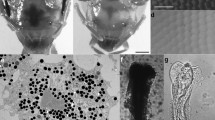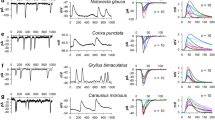Summary
In the ommatidia of Musca, the light flux transmitted by each one of the rhabdomeres of sense cells no. 1 to 6 decreases as a function of time if light falls onto these rhabdomeres. With a similar time course the light flux reflected from these rhabdomeres increases. These changes take place within a few seconds following illumination. The results have been established in the intact animal using changes in the appearance of the pseudopupil as indicator and also in surviving preparations of the eye with direct inspection of the rhabdomeres.
The changes are interpreted as a consequence of interactions between pigment granules in the sense cells and electromagnetic fields induced outside the rhabdomeres by light travelling on the inside: In the dark adapted situation the granules are quite distant from the rhabdomeres, the interaction is negligible. During light adaptation the granules move close to the rhabdomeres, and as a consequence, total reflection of the light in the rhabdomere is frustrated. The relatively rapid changes in the optical characteristics of the rhabdomeres are explained by the fact that the distance, the granules have to move in order to switch from one condition to the other is in principle on the order of the wavelength of light.
The results indicate, that the changes in the position of the granules are induced by the excitation of the respective sense cells themselves, for instance by the degree of their depolarisation. No interaction between the sense cells of one ommatidium nor between those of different ommatidia could be found.
The function of the movement of the pigment granules is interpreted as a means to protect the sense cells no. 1 to 6 against strong illumination. — Movement of pigment granules is not induced in sense cells no. 7 and 8 with light intensities which give maximal response in sense cells no. 1 to 6.
Similar content being viewed by others
Literatur
Barer, R.: Refractometry and interferometry of living cells. J. opt. Soc. Amer. 47, 545–556 (1967).
Braitenberg, V.: Patterns of projection in the visual system of the fly. I. Retina-Lamina projections. Exp. Brain Res. 3, 271–298 (1967).
Demoll, R.: Über eine lichtzersetzliche Substanz im Facettenauge, sowie über eine Pigmentwanderung im Appositionsauge. Pflügers Arch. ges. Physiol. 129, 461–475 (1909).
Eguchi, E., and T. H. Waterman: Changes in retinal fine structure induced in the crab Libinia by light and dark adaptation. Z. Zellforsch. 79, 209–229 (1967).
Fermi, G., u. W. Reichardt: Optomotorische Reaktionen der Fliege Musca domestica. Abhängigkeit der Reaktion von der Wellenlänge, der Geschwindigkeit, dem Kontrast und der mittleren Leuchtdichte bewegter periodischer Muster. Kybernetik 2, 15–28 (1963).
Fernandez-Morán, H.: Fine structure of the light receptors in the compound eyes of insects. Exp. Cell Res., Suppl. 5, 586–644 (1958).
Franceschini, N., and K. Kirschfeld: An automatic gain control in the photoreceptors of diptera. Kybernetik (in preparation).
Goldsmith, T. H., and D. E. Philpott: The microstructure of compound eyes in insects. J. biophys. biochem. Cytol. 3, 429–440 (1957).
Horridge, G. A., and P. B. T. Barnard: Movement of palisade in Locust retinula cells when illuminated. Quart. J. micr. Sci. 106, 131–135 (1965).
Jörschke, H.: Die Facettenaugen der Orthopteren und Termiten. Z. wiss. Zool. 111, 153–280 (1914).
Kapany, N. S., and J. J. Burke: Fibre optics. IX. Waveguide effects. J. opt. Soc. Amer. 51, 1067–1078 (1961).
Kirschfeld, K.: Das anatomische und das physiologische Sehfeld der Ommatidien im Komplexauge von Musca. Kybernetik 2, 249–257 (1965).
—: Die Projektion der optischen Umwelt auf das Raster der Rhabdomere im Komplexauge von Musca. Exp. Brain Res. 3, 248–270 (1967).
—: Absorption properties of single rods, cones and rhabdomeres. Proceedings of the Internat. School of Physics Enrico Fermi: Processing of optical data by organisms and by machines. New York: Academic Press 1969.
—, u. N. Franceschini: Optische Eigenschaften der Ommatidien im Komplexauge von Musca. Kybernetik 5, 47–52 (1968).
Kuiper, J. W.: The optics of the compound eye. Symp. Soc. exp. Biol. 16, 58–71 (1962).
Langer, H.: Nachweis dichroitischer Absorption des Sehfarbstoffes in den Rhabdomeren des Insektenauges. Z. vergl. Physiol. 51, 258–263 (1965).
McCann, G. D., and G. F. MacGintie: Optomotor response studies of insect vision. Proc. roy. Soc. London B 163, 369–401 (1965).
Melamed, J., and O. Trujillo-Cenóz: The fine structure of the central cells in the ommatidia of dipterans. J. Ultrastruct. Res. 21, 313–334 (1968).
Nilsson, S. E.: The ultrastructure of the receptor outer segments in the retina of the leopard frog (Rana pipiens). J. Ultrastruct. Res. 12, 207–231 (1965).
Parker, G. H.: The movements of the retinal pigment. Ergebn. Biol. 9, 239–291 (1932).
Röhlich, P., and L.J. Török: The effect of light and darkness on the fine structure of the retinal clubs of Dendrocoelum lacteum. Quart. J. micr. Sci. 103, 543–548 (1962).
Seitz, G.: Der Strahlengang im Appositionsauge von Calliphora erythrocephala (Meig). Z. vergl. Physiol. 59, 205–231 (1968).
Sidman, R. L.: The structure and concentration of solids in photoreceptor cells studied by refractometry and interference microscopy. J. biophys. biochem. Cytol. 3, 15–29 (1957).
Stockhammer, K.: Zur Wahrnehmung der Schwingungsrichtung linear polarisierten Lichtes bei Insekten. Z. vergl. Physiol. 38, 30–83 (1956).
Thorson, J.: Small-signal analysis of a visual reflex in the locust. I., II. Kybernetik 3, 41–66 (1966).
Trujillo-Cenóz, O., and J. Melamed: Electron microscope observations on the peripheral and intermediate retinas of dipterans. The functional organization of the compound eye. Proceedings of the Internat. Symposium held in Stockholm, October 1965, Wenner-Gren Center, Internat. Symp. Series, Vol. 7. Oxford: Pergamon Press 1966.
—: Compound eye of dipterans: Anatomical basis for integration — an electron microscope study. J. Ultrastruct. Res. 16, 395–398 (1966).
Tuurala, O., u. A. Lehtinen: über die Wandlungen in der Feinstruktur der Lichtsinneszellen bei der Hell- und Dunkeladaptation im Auge einer Asselart Oniscus Asellus L. Ann. Acad. Sci. fenn. A, IV 123, 3–7 (1967b).
—: Zu den photomechanischen Erscheinungen im Auge der Gewächshausheuschrecke Tachycines asynamorus. Adel, Commentationes Biol. Soc. Sci. Fenn. 30, l-4 (1967a).
— u. M. Nyholm: Zu den photomechanischen Erscheinungen im Auge einer Asselart, Oniscus Asellus L. Ann. Acad. Sci. fenn. A, IV 99, 1–8 (1966).
Vries, H. de: Physical aspects of sense organs. Progr. Biophys. 6, 207–264 (1956).
Weizel, W.: Lehrbuch der theoretischen Physik, Bd. 1. Berlin-Göttingen-Heidelberg: Springer 1955.
Wolken, J.J., J. Capenos, and A. Turano: Photoreceptor structures. III. Drosophila melanogaster. J. biophys. biochem. Cytol. 3, 441–448 (1957).
Woolbarsht, M. L., H. G. Wagner, and D. Bodenstein: Origin of the electrical response in the eye of Periplaneta Americana. In: The functional organization of the compound eye (ed. C. G. Bernhard). Wenner Gren Center, Internat. Symp. Series, Vol. 7. Oxford: Pergamon Press 1966.
Author information
Authors and Affiliations
Additional information
Wertvolle Diskussionen verdanken wir Herrn Dr. K. G. Götz sowie Herrn Prof. W. Reichardt. Wir danken Fräulein T. Wiegand für Mithilfe bei den Experimenten sowie Herrn E. Freiberg für das Fertigstellen der Abbildungen.
Rights and permissions
About this article
Cite this article
Kirschfeld, K., Franceschini, N. Ein Mechanismus zur Steuerung des Lichtflusses in den Rhabdomeren des Komplexauges von Musca . Kybernetik 6, 13–22 (1969). https://doi.org/10.1007/BF00288624
Received:
Issue Date:
DOI: https://doi.org/10.1007/BF00288624




